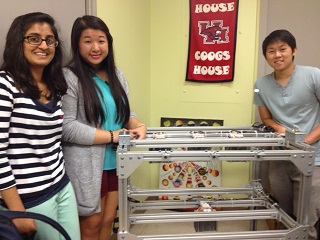A ride in the “vomit comet” may not be for everyone, but then, few people get the opportunity.
“I don’t think a lot of people would be able to say they had done that,” Steven Hong said.
Hong, a sophomore petroleum engineering student at the University of Houston, and his teammates soon will get their chance to fly in the “comet,” also known as NASA’s reduced gravity aircraft.
The team is working with a NASA scientist to design, build, fly and evaluate an experiment based on NASA research and, as part of the Reduced Gravity Education Flight Program, will perform their experiment aboard a microgravity aircraft that produces periods of weightlessness for up to 25 seconds at a time.
Hong is part of the five-student Cougarnaut team; all signed up last spring as freshmen and are now sophomores.
Their project – to freeze water in a reduced gravity environment – isn’t what they initially proposed. And the system they ultimately designed and built isn’t based on their first idea. Or even their second.
Aashini Patel, a biomedical engineering major, said they learned through trial and error.
“Nothing really works out as you plan it,” she said.
Lisa Nguyen and Muskan Agarwal, both biomedical engineering majors, and Luciano Posada,
a chemical engineering major, completed the team. Agarwal transferred to Rice University
over the summer; Posada transferred to the 
That made working on the project more difficult; the students did most of the work on weekends, meeting on the UH campus.
Another lesson learned?
“Order extra,” Nguyen said. “You’ll need it.”
The students originally proposed studying the behavior of cells in microgravity and asked Ann Cheek, an instructional assistant professor of biology, to serve as their faculty mentor.
But NASA assigned a different project after they were accepted into the program, and Cheek worked to find support from engineering faculty, as well as lab space.
Dong Liu, associate professor of mechanical engineering, and two of his graduate students helped the Cougarnauts with design and structural analysis. Dave Shattuck, associate dean for undergraduate programs for the Cullen College of Engineering, helped ensure the project received funding from the college.
Patel said Katherine Zerda, director of the Program for Mastery in Engineering Studies (PROMES), helped the team order supplies and understand the financial aspects of the project, and also provided space to work in a corner of the PROMES lounge.
NASA researcher Scott Hansen also served as a mentor, and the students touched base with him every week, other than during the federal government shutdown.
“No matter what you do, water will expand when it freezes,” Hong said.
But it will behave differently in microgravity, and Patel said the group ultimately devised two systems, along with a control system, for the experiment.
They will test and record all three during two flights to determine which method freezes the water most quickly, and how freezing affects the water.
According to NASA, the flight achieves periods of weightlessness through a series of about 30 roller coaster-like parabolas over the Gulf of Mexico. During the free falls, the students will gather data in the environment, which mimics space.
The UH team was selected for the Minority University Research and Education Program based on scientific merit and educational outreach potential, and the students said they will talk with middle school students to encourage them to study engineering and other science and math fields.
They report to Ellington Field Nov. 8, and every weekday for the next week for training and to make their flights. Afterward, they will evaluate their findings and provide the results to NASA.
But they already have drawn one conclusion.
"What we’re learning in class really is applicable to real life,” Hong said. “There is a reason we learned it.”